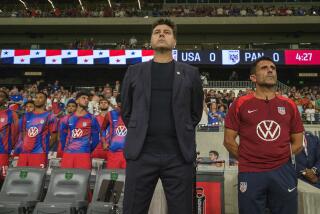U.S. Gets No Kick From Soccer
- Share via
Performing in soccer the other night amid the historic splendor of the Los Angeles Coliseum, whose preservation exceeds in importance that of any of the great pyramids, the Soviet Union and Colombia drew only 18,000.
Certainly, one was dealing here with box office nations, appearing in the news almost as much as the Trumps.
And now, as before, one inspecting attendance was led to ask oneself that question of vital sociological concern--why won’t U.S. spectators go for soccer?
Soccer is an excellent game, appreciated by viewers the planet over. If something exists that may be called the true international sport, it would be soccer. Its World Cup enjoys status of an athletic classic.
But whatever the effort of soccer to establish a beachhead in the United States, whatever arguments made in the game’s behalf, soccer has lost its bladder.
And, professionally today, the sport here is reduced to an endeavor labeled indoor soccer, performed under a roof on a short field flanked by plexiglass boards, off which the ball can be played on the carom, as in jai alai.
Whereas standard soccer features 11 to a side, indoor calls for six. And if you wonder idly what an indoor participant looks like, be assured he comes with one head, two arms, two legs and the usual number of fingers and toes.
The indoor league, once comprising 12 teams, is down to eight, struggling to keep its pulse in the tradition of any form of pro soccer in this country.
Convinced in 1967 that outdoor soccer stood on the doorsill of greatness in North America, promoters put together two leagues, consisting of 22 teams. Such confidence was vested in the sport that the rival leagues, amazingly, overlapped in five cities.
Los Angeles, for instance, was the home of the Toros and the Zorros, the latter owned by Jack Kent Cooke, who exclaimed rapturously: “What a marvelous game! Do you realize you can outfit a whole soccer team for what it costs to dress one football player?”
Making sure he had a place large enough to accommodate the throngs, Jack booked his games in the Rose Bowl, capacity 106,000. Opening night, he looked wistfully at a Zorro audience of 1,251.
The Toros selected as home the L.A. Coliseum, capacity 93,000. Asked by a sportswriter for two tickets to the opener, the publicist responded, “How about a section?”
If one got into a soccer deal, who needed Lincoln Savings?
Feeling it had found the Lost Dutchman mine, CBS came aboard, blowing an immense amount of money in putting the games on the air.
Those who like soccer still aren’t able to believe they have on their hands in this country a spectator disaster. The game, they argue, has a massive base, stemming from 8,000,000 amateurs who are playing the sport at levels ranging from 4-year-olds to the NCAA.
Fans, soccer boosters insist, identify with the pro players, who are average in appearance. They don’t weigh 275. They don’t rise 7 feet. They have the teeth they came with.
When the late Abe Saperstein formed the American Basketball League, he promised to put players on the floor of normal height.
“The public is sick of looking at freaks,” announced Abe, who, crashing with his league, misread public taste.
Are soccer players too normal for the game’s good?
Those trying to explain why the sport can’t build a flame in American hearts usually begin by noting that soccer bucks baseball, and is judged by football.
Will fans accustomed to watching the 49ers move the ball sit still for a Soviet Union-Colombia match the other night, ending 1-0 with a penalty kick in overtime?
In soccer, 1-0 can be a slugfest. The Netherlands and Italy, two of the world’s top teams, played to a scoreless draw earlier in the week.
Then it has been asked whether Americans reject soccer because teams here have featured too many foreigners? Well, baseball brims with Dominicans, Puerto Ricans, Cubans and Panamanians, and the only ones rejected are those who hit .210.
But, for all its reversals in the United States, soccer remains hopeful.
The general manager of the Wichita Wings assured us one day: “It’s just a matter of getting our foot in the American door. We have a fast, lively product. Our players are appealing. They don’t wear pads, helmets, or face masks. And the ball is easier to follow than a puck.”
It even may be easier to follow than a horse on the backstretch.
Soccer makes a compelling argument. All it has to do is sell it to those who don’t buy its tickets.






